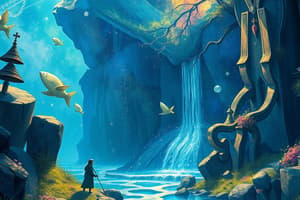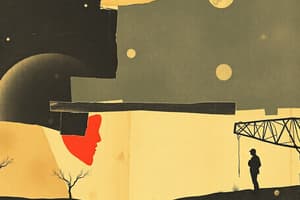Podcast
Questions and Answers
Match the following types of poetry with their descriptions:
Match the following types of poetry with their descriptions:
EPIC = narrative poem that praises an individual, commemorates an event, or describes nature ODE = long unified narrative poem, recounting the adventures of a warrior, a king or a god METRICAL ROMANCE = lyric poem that expresses sorrow or lamentation for the one who has died METRICAL TALE = narrative poem that is meant to be sung, usually composed in the ballad stanza
Match the following poetic forms with their characteristics:
Match the following poetic forms with their characteristics:
SONNET = written in elegiac couplets that expresses sorrow or lamentation BALLAD = short poem with 14 lines usually written in a specific kind of meter ELEGY = narrative poem that recounts the quest of a single knight to gain a lady's favor SONG = dignified and elaborately structured lyric poem praising an individual or event
Match the following poetic devices with their descriptions:
Match the following poetic devices with their descriptions:
SOLILOQUY = act of speaking to others, usually to reveal innermost thoughts and feelings MONOLOGUE = act of speaking while alone, especially in a theatrical device DRAMATIC POETRY = written work that emphasizes innovation in technique EXPERIMENTAL POETRY = when a character reveals their thoughts and feelings through a poem or speech
Match the following poetic forms with their descriptions:
Match the following poetic forms with their descriptions:
Match the following poetic forms with their descriptions:
Match the following poetic forms with their descriptions:
Match the following poetic devices with their descriptions:
Match the following poetic devices with their descriptions:
Match the following poetic forms with their descriptions:
Match the following poetic forms with their descriptions:
Match the following poetic devices with their descriptions:
Match the following poetic devices with their descriptions:
Match the poetry terms with their definitions:
Match the poetry terms with their definitions:
Match the poetry terms with their descriptions:
Match the poetry terms with their descriptions:
Match the poetry terms with their explanations:
Match the poetry terms with their explanations:
Match the poetry terms with their components:
Match the poetry terms with their components:
Match the poetry terms with their functions:
Match the poetry terms with their functions:
Match the poetry terms with their characteristics:
Match the poetry terms with their characteristics:
Match the poetry terms with their relationships:
Match the poetry terms with their relationships:
Match the poetry terms with their examples:
Match the poetry terms with their examples:
Match the poetry forms with their characteristics:
Match the poetry forms with their characteristics:
Match the poetry forms with their creators:
Match the poetry forms with their creators:
Match the poetry forms with their syllable structure:
Match the poetry forms with their syllable structure:
Match the poetry forms with their themes:
Match the poetry forms with their themes:
Match the poetry forms with their number of lines:
Match the poetry forms with their number of lines:
Match the poetry forms with their rhyming patterns:
Match the poetry forms with their rhyming patterns:
Match the poetry forms with their origins:
Match the poetry forms with their origins:
Match the poetry forms with their emotional conveyance:
Match the poetry forms with their emotional conveyance:
Match the following poetic devices with their descriptions:
Match the following poetic devices with their descriptions:
Match the following poetic devices with their descriptions:
Match the following poetic devices with their descriptions:
Match the following types of poetry with their characteristics:
Match the following types of poetry with their characteristics:
Match the following poetic devices with their descriptions:
Match the following poetic devices with their descriptions:
Match the following poetic devices with their descriptions:
Match the following poetic devices with their descriptions:
Match the following poetic devices with their descriptions:
Match the following poetic devices with their descriptions:
Match the following poetic devices with their descriptions:
Match the following poetic devices with their descriptions:
Match the following poetic devices with their descriptions:
Match the following poetic devices with their descriptions:
Match the following senses with the correct image appeal:
Match the following senses with the correct image appeal:
Match the following lines with their corresponding poem:
Match the following lines with their corresponding poem:
Match the following poem characteristics with their corresponding type:
Match the following poem characteristics with their corresponding type:
Match the following rhyme schemes with their corresponding poem type:
Match the following rhyme schemes with their corresponding poem type:
Match the following poem titles with their corresponding type:
Match the following poem titles with their corresponding type:
Match the following poetic devices with their corresponding poem type:
Match the following poetic devices with their corresponding poem type:
Match the following lines with their corresponding poem theme:
Match the following lines with their corresponding poem theme:
Match the following poem structures with their corresponding poem type:
Match the following poem structures with their corresponding poem type:
What is the primary function of a foot in poetry?
What is the primary function of a foot in poetry?
What is the term for the repeating pattern of stressed and unstressed syllables in a poem?
What is the term for the repeating pattern of stressed and unstressed syllables in a poem?
What is the term for the beat created by the sounds of words in a poem?
What is the term for the beat created by the sounds of words in a poem?
What is the term for the arrangement of lines in a poem?
What is the term for the arrangement of lines in a poem?
What is the term for the author of a poem?
What is the term for the author of a poem?
Flashcards are hidden until you start studying
Study Notes
Poetry Overview
- Poetry is a type of literature that expresses ideas, feelings, or tells a story in a specific form, usually using lines and stanzas.
- The poet is the author of the poem, while the speaker is the narrator of the poem.
Poetry Form
- Form refers to the appearance of the words on the page.
- A line is a group of words together on one line of the poem.
- A stanza is a group of lines arranged together.
Kinds of Stanzas
- Couplet: a two-line stanza
- Triplet (Tercet): a three-line stanza
- Quatrain: a four-line stanza
- Quintet: a five-line stanza
- Sestet (Sextet): a six-line stanza
- Septet: a seven-line stanza
- Octave: an eight-line stanza
Sound Effects
- Rhythm: the beat created by the sounds of the words in a poem.
- Rhythm can be created by meter, rhyme, alliteration, and refrain.
- Meter: a pattern of stressed and unstressed syllables.
- Meter occurs when the stressed and unstressed syllables of the words in a poem are arranged in a repeating pattern.
- Foot: a unit of meter.
- Types of feet: determined by the arrangement of stressed and unstressed syllables.
Narrative Poetry
- Presents one or more characters speaking, usually to other characters, but sometimes to themselves or directly to the reader.
- Types of narrative poetry:
- Epic: a long, unified narrative poem, recounting the adventures of a warrior, a king, or a god.
- Metrical Romance: recounts the quest undertaken by a single knight to gain a lady's favor.
- Metrical Tale: relates to real or imaginary events in simple, straightforward language.
- Ballad: a narrative poem meant to be sung, usually composed in the ballad stanza.
Lyric Poetry
- Ode: a dignified and elaborately structured lyric poem praising and glorifying an individual, commemorating an event, or describing nature.
- Elegy: a lyric poem that expresses sorrow or lamentation, usually for the one who has died.
- Sonnet: a short poem with 14 lines, usually written in a specific kind of meter.
- Song: a lyric poem set to music, with a strong beat created through rhythm, rhyme, and repetition.
- Simple Lyric: a short poem that expresses the poet's thought, feeling, or emotion.
Dramatic Poetry
- Dramatic Monologue: when a character reveals their innermost thoughts and feelings through a poem or speech.
- Soliloquy: the act of speaking while alone, especially when used as a theatrical device to convey a character's thoughts and ideas to the audience.
Specific Forms of Creative Poetry
- Experimental Poetry: written work that emphasizes innovation, especially in technique.
- Acrostic Poetry: a poem where the letters of each line are aligned vertically to form a word, often the subject of the poem.
- Limerick: a funny little poem with five lines, where the last words of the first, second, and fifth lines rhyme with each other.
- Haiku: a Japanese poem with 17 syllables, featuring nature as its subject or theme, with a 5-7-5 syllable structure.
- Tanka: a Japanese poem with 31 syllables, featuring themes of love, nature, seasons, and friendship, with a 5-7-5-7-7 syllable structure.
- Concrete Poetry: poetry where the visual appearance matches the topic of the poem, often forming shapes that illustrate the poem's subject.
- Typography: the art and technique of arranging type to make written language legible, readable, and appealing.
Rhyme and Rhyme Schemes
- End Rhyme: a word at the end of one line rhymes with a word at the end of another line.
- Internal Rhyme: a word inside a line rhymes with another word on the same line.
- Near Rhyme: a word shares either the same vowel or consonant sound but not both.
- Rhyme Scheme: a pattern of rhyme, usually end rhyme, represented by letters of the alphabet to visualize the pattern.
Dramatic Poetry
- Presents one or more characters speaking, usually to other characters, but sometimes to themselves or directly to the reader.
Kinds of Narrative Poetry
- EPIC: long unified narrative poem, recounting in dignified language the adventures of a warrior, a king, or a god.
- METRICAL ROMANCE: recounts the quest undertaken by a single knight in order to gain a lady's favor.
- METRICAL TALE: relates to real or imaginary events in simple, straight forward language, from a wide range of subjects, characters, life experiences, and emotional situations.
- BALLAD: narrative poem which is meant to be sung, usually composed in the ballad stanza.
Kinds of Lyric Poetry
- ODE: dignified and elaborately structured lyric poem praising and glorifying an individual, commemorating an event or describing nature intellectually rather than emotionally.
- ELEGY: a lyric poem, written in elegiac couplets that expresses sorrow or lamentation usually for the one who has died.
- SONNET: short poem with 14 lines usually written in a specific kind of meter.
- SONG: lyric poem which is set to music, with a strong beat created largely through the 3Rs: rhythm, rhyme, and repetition.
- SIMPLE LYRIC: short poem that expresses the poet's thought, feeling, or emotion.
Kinds of Dramatic Poetry
- DRAMATIC MONOLOGUE: when a character reveals his or her innermost thoughts and feelings, those that are hidden throughout the story line through a poem or a speech.
- SOLILOQUY: act of speaking while alone, especially when used as a theatrical device that allows a character's thoughts and ideas to be conveyed to the audience.
Specific Forms of Creative Poetry
- EXPERIMENTAL POETRY: written work that emphasizes innovation, most especially in technique.
- ACROSTIC POETRY: the letters of each line are aligned vertically to form a word, which is often the subject of the poem.
Poetry Forms
- LINE: a group of words together on one line of the poem.
- STANZA: a group of lines arranged together.
- KINDS OF STANZAS:
- Couplet: a two-line stanza.
- Triplet (Tercet): a three-line stanza.
- Quatrain: a four-line stanza.
- Quintet: a five-line stanza.
- Sestet (Sextet): a six-line stanza.
- Septet: a seven-line stanza.
- Octave: an eight-line stanza.
Sound Effects
- RHYTHM: the beat created by the sounds of the words in a poem, which can be created by meter, rhyme, alliteration, and refrain.
- METER: a pattern of stressed and unstressed syllables, which occurs when the stressed and unstressed syllables of the words in a poem are arranged in a repeating pattern.
- FOOT: unit of meter, which can have two or three syllables, determined by the arrangement of stressed and unstressed syllables.
- TYPES OF FEET: determined by the arrangement of stressed and unstressed syllables.
Studying That Suits You
Use AI to generate personalized quizzes and flashcards to suit your learning preferences.




